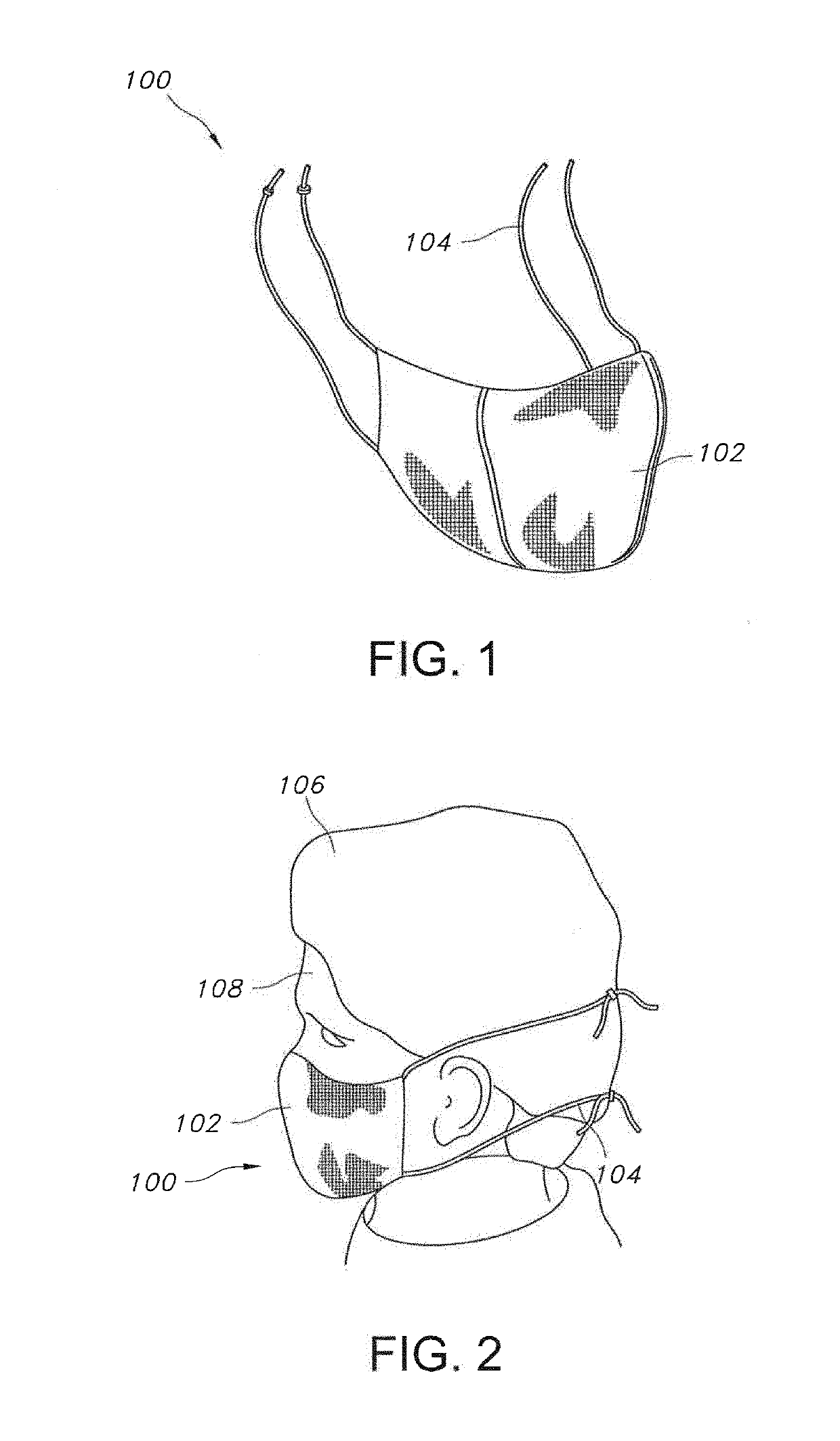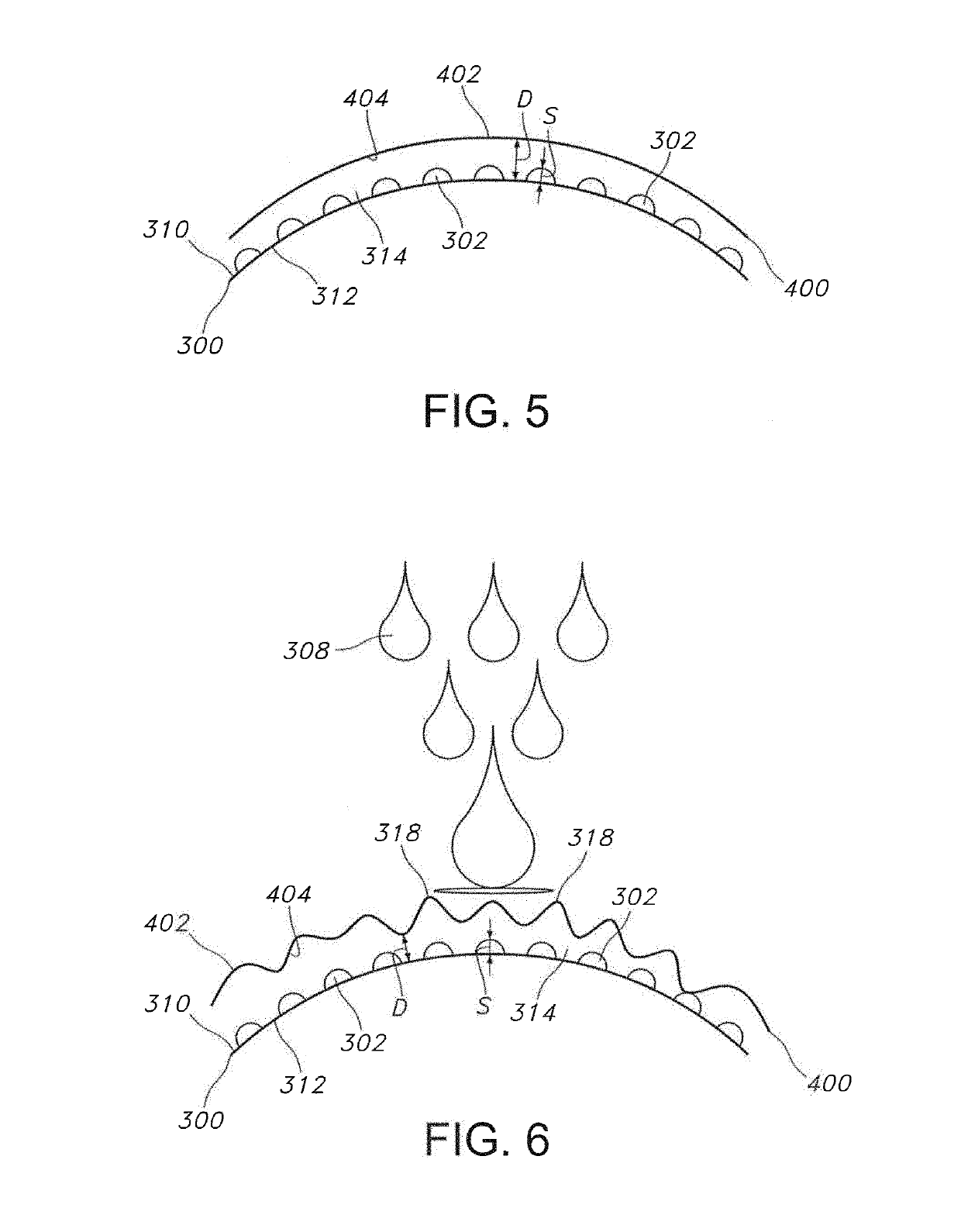Face mask having improved comfort through cooling of microclimate through use of a phase change material
a technology of phase change material and comfort layer, which is applied in the direction of breathing protection, protective equipment, protective garments, etc., can solve the problems of increasing the cost of the structure, increasing the weight of the structure, and reducing the porosity of the structur
- Summary
- Abstract
- Description
- Claims
- Application Information
AI Technical Summary
Benefits of technology
Problems solved by technology
Method used
Image
Examples
example 1
[0156]In Example 1, the temperature profiles for the microclimate inside the dead space of pleated face masks having a length of 17.5 centimeters and a width of 18.4 centimeters, where the inner-facing surface of the inner layer has a surface area of 0.032 m2 and incorporating various configurations of an encapsulated phase change material disposed on a nonwoven polyester substrate, were recorded via thermal imaging and compared to a control mask that did not include an encapsulated phase change material, and the results are shown in the time lapse images shown in FIGS. 15-17. Specifically, FIG. 15 illustrates a thermal imaging profile during inhaling (left) and exhaling (right) over a 45 minute period for a user wearing the control face mask of Example 1, where no phase change material is present on the inner-facing surface of the inner layer of the face mask; FIG. 16 illustrates a thermal imaging profile during inhaling (left) and exhaling (right) over a 45 minute period for a use...
example 2
[0161]In Example 2, the temperature profiles for the microclimate inside the dead space of several types of face masks incorporating various configurations of an encapsulated phase change material disposed on a nonwoven polyester substrate were recorded via thermal imaging and compared to a control mask that did not include an encapsulated phase change material, and the results are shown in the time lapse images shown in FIGS. 18-40. The pleated face masks tested in FIGS. 18-27, 30-34, and 36-40 have a length of 17.5 centimeters and a width of 18.4 centimeters, where the inner-facing surface of the inner layer has a surface area of about 0.032 m2, while the inner-facing surface of the inner layer of the mask tested in FIGS. 28 and 35 has a total surface area of about 0.023 m2, and the inner-facing surface of the inner layer of the mask tested in FIG. 29 has a total surface area of about 0.0305 m2. Further, when a 6 millimeter border was used, the surface area of the border was about...
example 3
[0195]In Example 3, a multi-layered structure generally corresponding to the arrangement shown in FIG. 9 (Control Sample) but without the three-dimensional spaces 302 was compared to a multi-layered structure arranged as shown in FIG. 9 (Test Sample) for their ability to achieve Level 3 performance, which is the most stringent level of testing in ASTM F2100-11, where a face mask must resist splashes of 2 milliliters of synthetic blood (available from Johnson, Moen & Co., 2505 Northridge Lane NE, Rochester, Minn. 55906) at 160 mmHg per the ASTM F1862-13 procedure. In other words, the control sample included the four-layered structure 860 except for the three-dimensional spacers 302. The control sample multi-layered structure had an outer layer of material 802 formed from a polyester pulp wetlaid material having a basis weight of 0.5 ounces per square yard (16.95 gsm) and having an outer-facing surface 810. The control sample multi-layered structure 860 also included an inner layer of...
PUM
| Property | Measurement | Unit |
|---|---|---|
| width | aaaaa | aaaaa |
| temperature | aaaaa | aaaaa |
| surface area | aaaaa | aaaaa |
Abstract
Description
Claims
Application Information
 Login to View More
Login to View More - R&D
- Intellectual Property
- Life Sciences
- Materials
- Tech Scout
- Unparalleled Data Quality
- Higher Quality Content
- 60% Fewer Hallucinations
Browse by: Latest US Patents, China's latest patents, Technical Efficacy Thesaurus, Application Domain, Technology Topic, Popular Technical Reports.
© 2025 PatSnap. All rights reserved.Legal|Privacy policy|Modern Slavery Act Transparency Statement|Sitemap|About US| Contact US: help@patsnap.com



